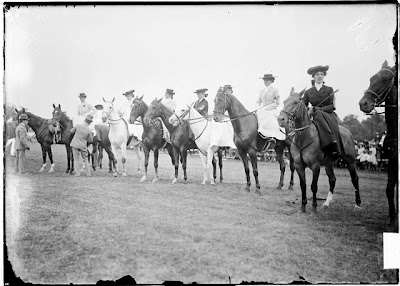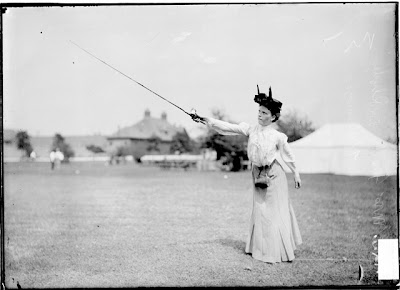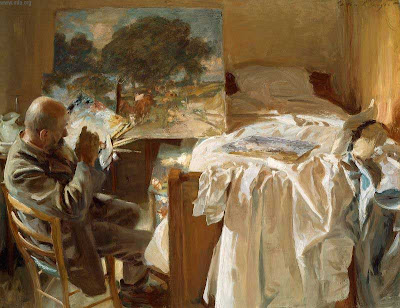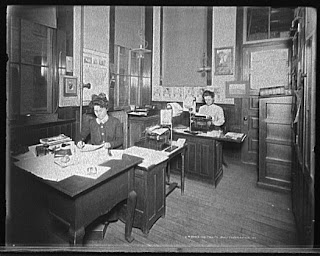
One of the many Boston-area sports highlights that have survived from 1905 to the present day is the annual football game between Harvard and Yale. That year, "The Game" took place at the
Harvard Stadium which was a spanking new facility--designed by the well-known architectural firm of McKim, Mead, and White, and just completed in 1903. (Today, a venerable ivy-covered horseshoe, it is the nation's oldest stadium, and a National Historic Landmark.) The photo above was taken on November 25, 1905, when 43,000 spectators jammed the stands. (Click on the photo to enlarge.)
During its first 25 years in the game, Yale had lost only 10 times. Harvard had smarted under this dominance, especially after losing to Yale 12-0 in the 1904 game. So in 1905, Harvard hired WIlliam R. Reid to coach the team, and to establish a plan and a process for improving Harvard football so that Harvard could have a good shot at beating Yale--not just in 1905 but every year thereafter.
Bill Reid had played for the Harvard team during his freshman and sophomore years, and had led Harvard to victory over Yale in 1898, scoring two touchdowns. And the last time Harvard had beaten Yale had been when Reid coached the team (uncompensated) during the 1901 season while he was studying for a master of arts degree at the college.
Not surprisingly, Harvard saw Reid as the key to consistent victories over Yale, and hired the California prep school teacher in the spring of 1905 for what the
New York Times called a "princely salary"--he was paid more than any other professor and in fact his salary approached that of Harvard President Charles W. Eliot.
Reid set about on a mission, which included a couple of innovations he introduced to the game of football--the development of the hand-off and the idea of a playbook. Reid wrote in his 1905 diary that "next year and hereafter it would be a good scheme . . . after the offense is planned . . . to start off the season with such a book".

Unfortunately, the Harvard team lost to Yale in 1905 by a score of 6-0, its fourth shut-out loss in a row. Controversy erupted during the game when Harvard player Francis Burr was smashed in the face by Yale tackler Jack Quill.
1905 was a tough year in U.S. football--by the end of the season three college players had been killed due to the violence of the game (mass formations and gang tackling were commonplace), and scores more seriously injured. During October, US President Theodore Roosevelt (Harvard '80) had called together the coaches of Harvard, Yale, and Princeton to help figure out a way to decrease the body count. "Brutality and foul play should receive the same summary punishment given to a man who cheats at cards," opined Roosevelt.
And the Harvard Overseers agreed--threatening to abolish football at the school. Reid was named to head up a committee at Harvard which drafted 19 rules to improve the safety of the game. In December, a New York meeting of 68 football-playing colleges was convened, and the group determined to form a new rules committee. Early in January, 1906, the new rules committee was merged with the old rules committee, and Reid became secretary of the new group. In putting forth the Harvard-developed rules, Reid announced: "Either these 19 rules go through or there will be no more football at Harvard; and if Harvard throws out the game, many other colleges will follow Harvard's lead." Harvard had the clout to make that threat, the rules were adopted, and the Harvard Overseers agreed to let football continue.
Among the new rules drafted by Reid and adopted by the new committee were those changing the first-down yardage from 5 to 10 yards, creating a neutral zone at the line of scrimmage, and permitting the forward pass. In addition, the participants voted to get together annually to consider football issues. Thus emerged the National Collegiate Athletic Association, the body which still governs collegiate sports today. (It was originally constituted as the International Athletic Association of the U.S., and would be renamed the NCAA in 1910.)
Reid retired from college coaching at the end of the 1906 season (with a 30-3-1 record, but two 6-0 losses to Yale). But he is credited as the man who saved Harvard football and helped invent the modern game, and in 1970 he was ushered into the Football Hall of Fame for his achievements. Bill Reid died at the age of 97 in Brookline, Massachusetts.
Illustration Credits and ReferencesPhotograph of the 1905 Harvard Yale game courtesy of The Library of Congress.
Photograph of the game program from 1905 courtesy of the
Antique Athlete website.
Grinold, Jack. "Review of Big
-Time Football at Harvard, 1905: The Diary of Coach Bill Reid by Ronald A. Smith",
The New England Quarterly, Vol. 67, No. 4, (Dec., 1994), pp. 679-682.
Powers, John. "Landmark Celebration After 100 Years: Harvard Stadium Still Standing the Test of Time."
Boston Globe. Boston, Mass.: Nov 14, 2003. pg. E.1
Smith, Ronald A., "Harvard and Columbia and a Reconsideration of the 1905-06 Football Crisis",
Journal of Sport History, Vol. 8, No. 3 (Winter, 1981).
"Princely Salary to Coach: Harvard Will Give 'Bill' Reid $3,500 a Year for Football",
New York Times, February 24, 1905.
 In exploring the history of The Groton School in a recent post, I discovered that there were two well-documented punishments that the 6th form boys (the seniors) would administer to younger boys when they were considered to have broken the Groton code. These punishments were not officially sanctioned by Rector Peabody, but certainly allowed to go on without interference from him or the faculty.
In exploring the history of The Groton School in a recent post, I discovered that there were two well-documented punishments that the 6th form boys (the seniors) would administer to younger boys when they were considered to have broken the Groton code. These punishments were not officially sanctioned by Rector Peabody, but certainly allowed to go on without interference from him or the faculty.










